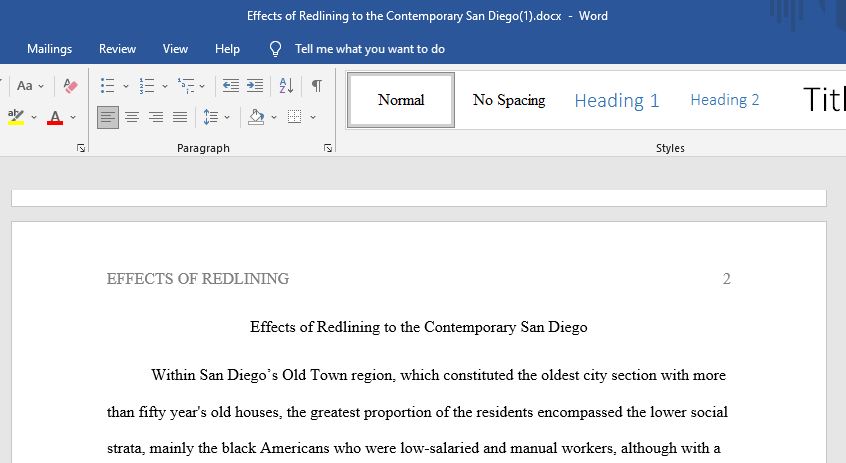Explain The long term effects of racial segregation
Redlining and other forms of residential segregation are intimately tied to the history of race in America. By zoning cities along to racialized lines, redlining has created and reproduced disparities in the lives and opportunities of different racial groups that are carried over generation after generation. Indeed, redlining shows the complexities and endurance of racial discrimination in the economy: because it is tied to both educational opportunities (through, for example, access to schools and public infrastructures) and wealth (through the value of home property), redlining becomes a highly persistent form of racialized discrimination.
In this exercise, you will have to assess the consequences of redlining to contemporary San Diego. For this, you will have to see how San Diego was originally redlined by consulting the online resource T-RACES at http://salt.umd.edu/T-RACES/demo/demo.html# (Links to an external site.). This resource allows you to explore the way San Diego was originally redlined into four distinct types of areas: Green, Blue, Yellow, and Red.
Step 1.
Use T-RACES to identify 6 San Diego neighborhoods representing at least two red districts, two yellow districts, one green district, and one blue district. Go to the website for T-RACES and, on the left drop down menu, select San Diego (the default is Oakland, CA).
You will then see a map of San Diego with the different redlined districts overlaid as shown below.
Expanding the menus on the left side of the screen, you will be able to find the different neighborhoods/districts classified as Green, Blue, Yellow, and Red. Navigate these and identify your six neighborhoods of interest.
You must then explore how each of these neighborhoods/districts were described and defined in back in 1936. Clicking on the neighborhood’s name will open a pop-up link on the map to a scan of the original redlining documents. These are original historical materials full of sociological insights!
Clicking on “View Area Description File” will open a window with the scan of the original redlining document pertaining to that neighborhood/district.
Observe that every district is coded (eg. A-1, C-2, D-7). If you would like to access information on all the descriptions for the districts, you can consult them through the menu on the right side of the screen.
From these documents, you must identify the following for each of the 6 neighborhoods:
1. What role did race play in the definition of the area? What patterns did you find? Are they consistent with redlining?
2. How was the area described materially (‘well maintained’, ‘conveniences’, ‘desirable’, etc)?
3. What role did social class play in the definition of the area (eg. ‘manual workers’, ‘low salaried’, ‘professional’)?
4. Did ideas of social class and race intersect?
Step 2.
Now let’s see what San Diego is like more than 80 years after redlining. Using the map from socialexplorer.com (Links to an external site.), look for the 6 neighborhoods that you identified from the redlining documents from 1936 (beware: some have changed names! Use the map to find the closest zip code to the districts you identified).
Socialexplorer.com contains a wealth of data, but what I want you to focus on is: 1) Race and Ethnicity (available in the demographics tab); 2) educational attainment (and in particular the percentage of people with bachelor’s degrees or higher); 3) per capita and median household income; 4) percentage of owner occupied housing units (available in the housing tab); and 5) Median house value.
Step 3.
Compare this data with the descriptions from the original redlining documents. Are there similarities? Are their differences? Does race still correlate with economic opportunities in San Diego?
Write up your findings in the form of a 700 word reflection. In this reflection I want you to compare and contrast the redlining documents from 1936 with the recent data. Doing this, I want you to say how race matters in San Diego today, and how this might be an indicator of how race matters more generally in contemporary American societies. Remember to use the readings to support your arguments. An optional reading on neighborhood segregation is provided in the reading list.
Requirements: Essay | 3 pages, Double spaced
https://www.voiceofsandiego.org/neighborhoods/how-…
Reading. No ourside sources
Answer preview:

word limit:692
